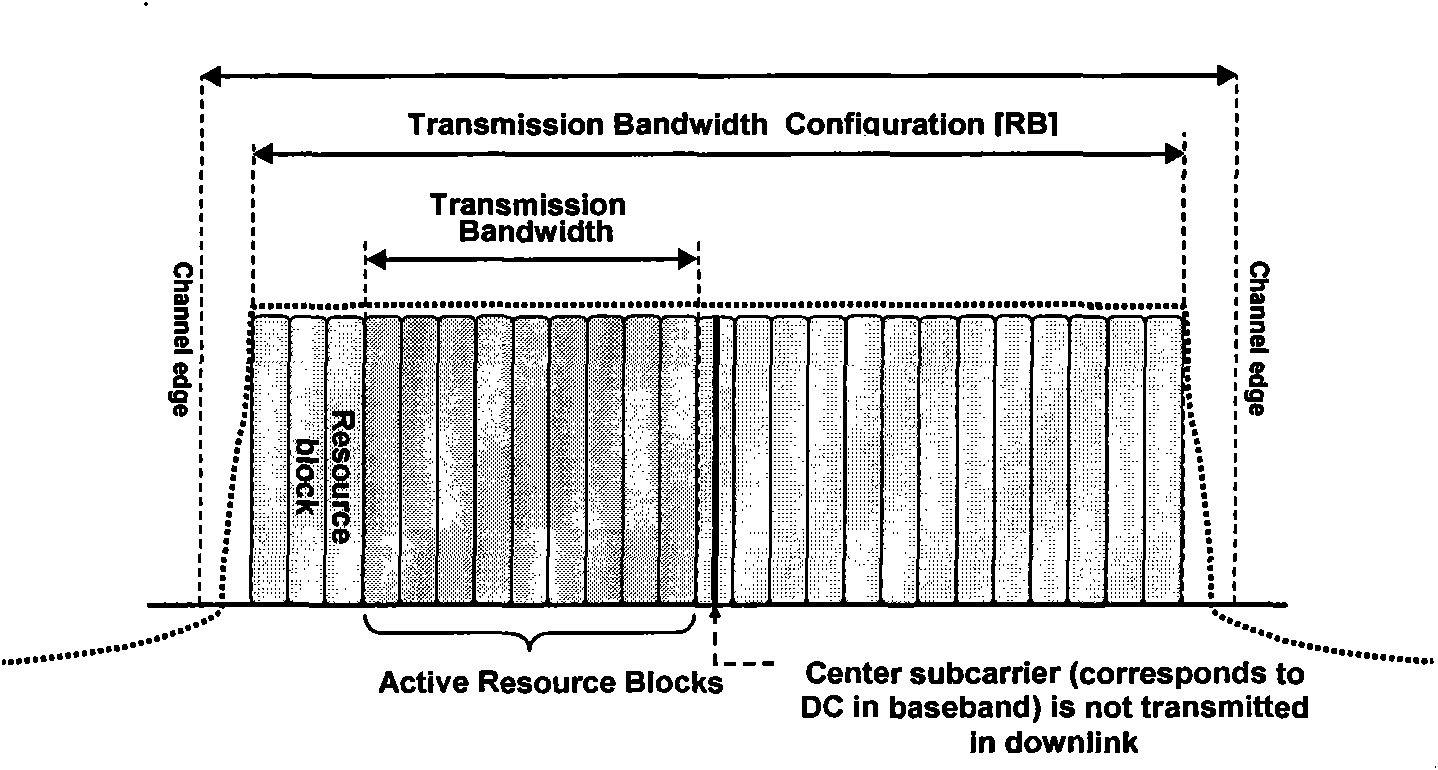Downlink dispatching information configuring method and equipment
A technology for scheduling information and terminal equipment, applied in the field of communication, can solve problems such as information loss, improve flexibility, ensure backward compatibility and system performance, and avoid the conflict between the carrier aggregation transmission mode and the DC carrier position.
- Summary
- Abstract
- Description
- Claims
- Application Information
AI Technical Summary
Problems solved by technology
Method used
Image
Examples
Embodiment 1
[0108] Embodiment 1. The downlink aggregation bandwidth configuration in the current system is set to 30MHz (the specific configuration composition is 10MHz+20MHz).
[0109] like Figure 4 As shown in , it is a schematic diagram of downlink aggregation bandwidth configuration in Embodiment 1 of the present invention. Assuming that the edge guard band is symmetrical, the downlink aggregated bandwidth configured as 10MHz component carrier 1 includes 600 subcarriers and 1 empty subcarrier (that is, the central carrier of component carrier 1), and the downlink aggregated bandwidth configured as 20MHz component carrier 2 includes There are 1200 subcarriers and 1 empty subcarrier (that is, the central carrier of CC2), and the number of empty subcarriers between CC1 and CC2 is 19.
[0110] Based on the above-mentioned downlink aggregation bandwidth configuration, the corresponding processing is as follows:
[0111] First, the base station acquires the current downlink aggregated ba...
Embodiment 2
[0128] Embodiment 2, setting the downlink aggregation bandwidth configuration in the current system to 50MHz (the specific configuration composition is 20MHz+10MHz+20MHz)
[0129] like Figure 5 As shown in , it is a schematic diagram of downlink aggregation bandwidth configuration in Embodiment 2 of the present invention. Assuming that the edge guard band is symmetrical, the downlink aggregated bandwidth configured as 20MHz component carrier 1 includes 1200 subcarriers and 1 empty subcarrier (that is, the central carrier of component carrier 1), and the downlink aggregated bandwidth is configured as 10MHz component carrier 2 includes 600 subcarriers and 1 empty subcarrier (that is, the central carrier of component carrier 2), and the downlink aggregation bandwidth configuration is 20MHz. The number of vacant subcarriers between 1 and component carrier 2, and between component carrier 2 and component carrier 3 is 19.
[0130] Based on the above-mentioned downlink aggregation...
Embodiment 3
[0164] Embodiment 3: The downlink aggregation bandwidth configuration in the current system is set to 30MHz (the specific configuration composition is 20MHz+10MHz).
[0165] like Image 6 As shown in , it is a schematic diagram of downlink aggregation bandwidth configuration in Embodiment 3 of the present invention.
[0166] In this case, the base station can virtualize the original 20MHz+10MHz asymmetric downlink aggregation carrier configuration into a 20MHz+20MHz symmetric downlink aggregation carrier configuration. The downlink scheduling information requires terminal equipment with a receiver processing capability of 20MHz+20MHz to receive signals. In this way, when the terminal equipment down-converts, the DC carrier falls in the center of the two component carriers, avoiding conflicts with the DC carrier.
[0167] Similar to this, the downlink aggregation bandwidth configuration of B+A can also be processed according to a similar process, and the description will not b...
PUM
 Login to View More
Login to View More Abstract
Description
Claims
Application Information
 Login to View More
Login to View More - R&D
- Intellectual Property
- Life Sciences
- Materials
- Tech Scout
- Unparalleled Data Quality
- Higher Quality Content
- 60% Fewer Hallucinations
Browse by: Latest US Patents, China's latest patents, Technical Efficacy Thesaurus, Application Domain, Technology Topic, Popular Technical Reports.
© 2025 PatSnap. All rights reserved.Legal|Privacy policy|Modern Slavery Act Transparency Statement|Sitemap|About US| Contact US: help@patsnap.com



